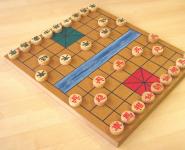Checkers rules (Russian, international, Brazilian, Italian, pool, checkers, giveaway)
The composition of the game:
1. Game board 64 (8x8) cells. Cells in two contrasting colors arranged diagonally. The designation of the game cells is alphanumeric (like on a chessboard).
2. Checkers of two different colors, 12 pieces each.
Purpose of the game:
Rules:
The playing field (board) is located in such a way that the corner dark field is located on the left side of the player (Diagram №1).
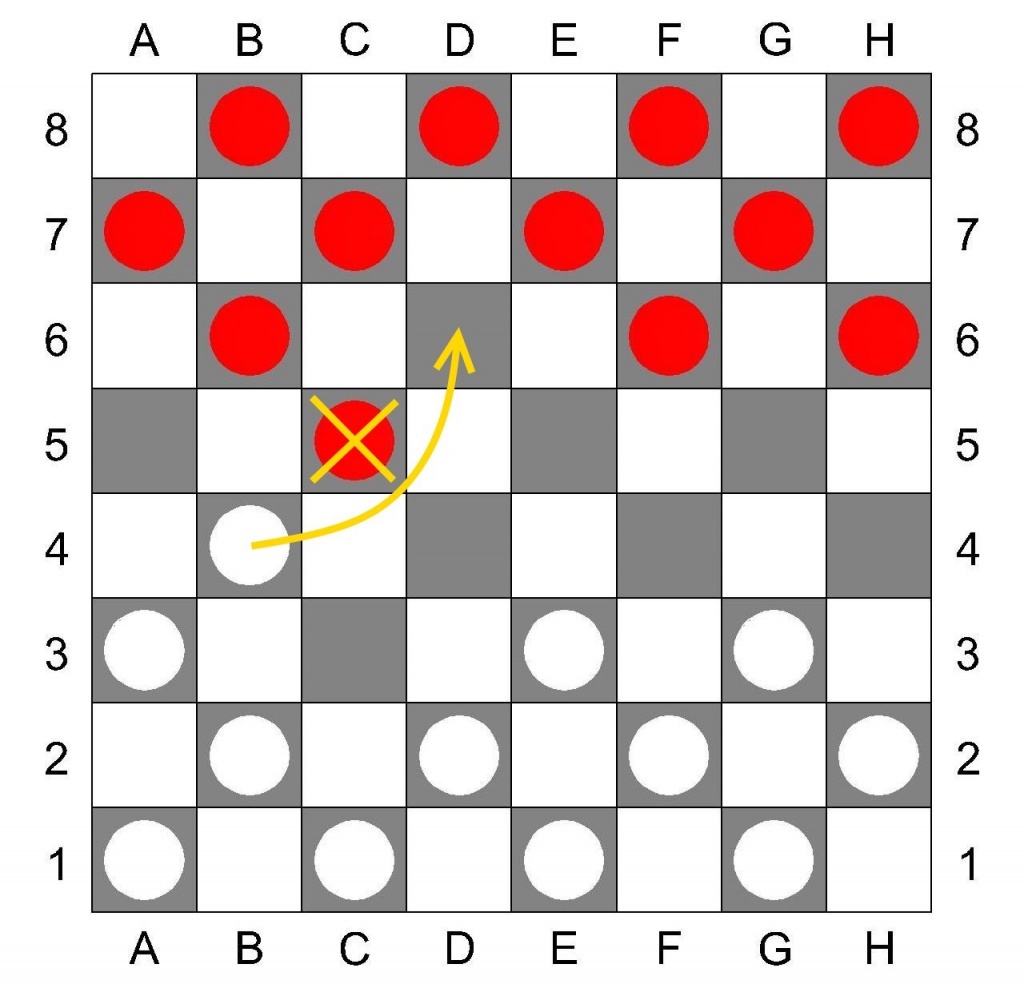 |
|
|
Diagram # 1 |
Diagram # 2 |
The choice of color by the players is determined by lot or by agreement. Checkers are placed on three rows closest to the player on dark cells, as shown in the picture. The first move usually belongs to the player who plays white (light). The moves are carried out by the opponents alternately.
If a simple checker reaches the last rank, it becomes a “king” and is indicated by a flip (Diagram №3). The queen can move along the diagonals to any number of free cells.
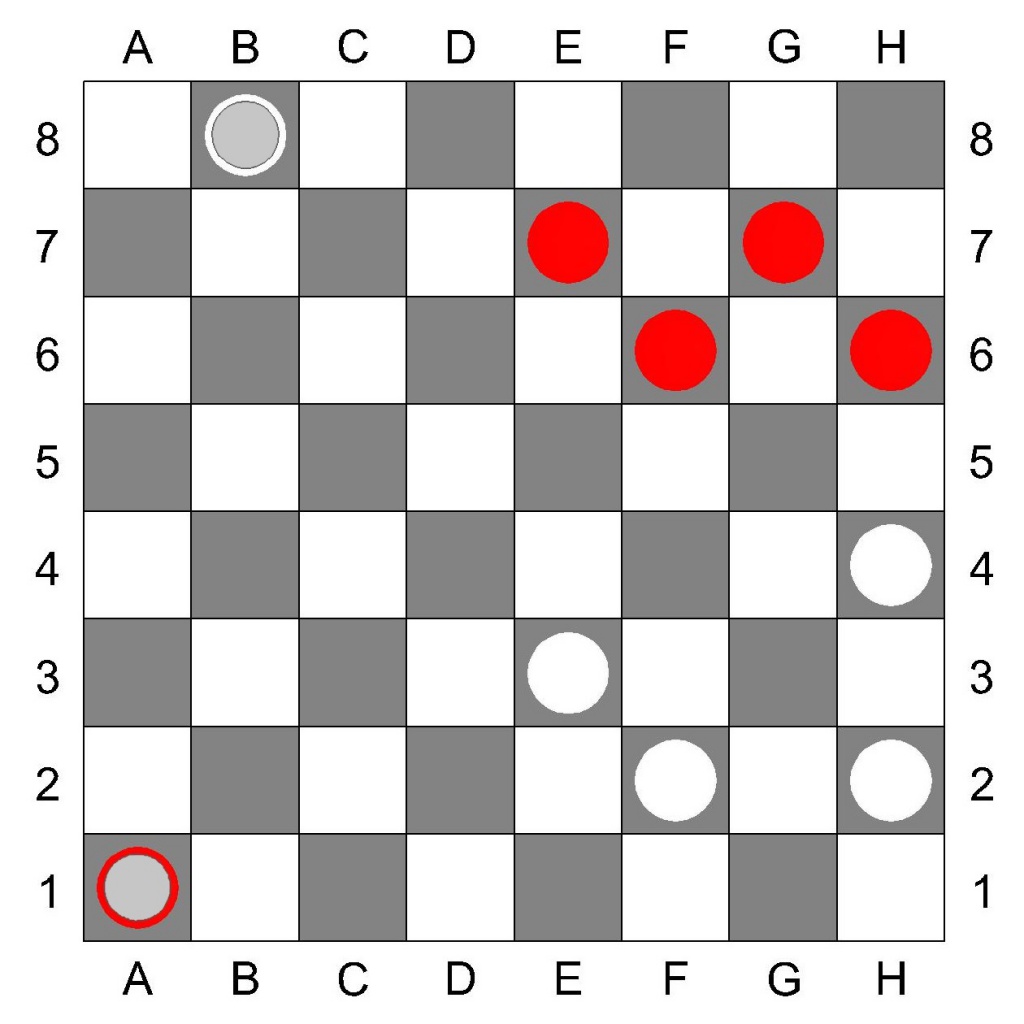
|
|
Diagram # 3 |
Taking a checker the opponent is carried out by transferring his own through it, if it is located on a diagonal square adjacent to a simple checker and there is a free field behind it (Diagram №2). If after this move there is a continuation for capturing other opponent's checkers, the move continues. The opponent's checker (s) is removed from the board. The capture of the opponent's checker can be carried out both forward and backward, and is obligatory, if before the start of the game it was not agreed to change this rule.
These rules of the game of Russian drafts are standard, but they can be changed by mutual agreement of the players.
International (100-cell) checkers.
The rules for playing international (100-cell) drafts are very similar to Russian drafts, but, nevertheless, differ.
The composition of the game:
1. Game board 100 (10x10) cells. Cells in two contrasting colors, usually white and dark (gray or brown), arranged diagonally. All dark (black) fields have specific numbers - from 1 to 50.
2. Checkers of two different colors, 20 pieces each.
Purpose of the game:
Win a game - when the opponent has no checkers left, the opponent's checkers are blocked, or the opponent admitted defeat ahead of schedule.
If it is impossible for any of the participants in the game to win, the game is considered to be ended in a draw.
Rules:
The game is played by 2 players. Players are positioned on opposite sides of the board.
The choice of color by the players is determined by lot or by agreement. Checkers are placed in four rows closest to the player on dark cells, as shown in the picture. The first move usually belongs to the player who plays white (light). The moves are carried out by the opponents alternately. A move is considered made if the participant of the game, after moving the checker, released his hand. If a player touched a checker, he is obliged to make a move to it. If any of the opponents wants to correct the checkers, he is obliged to warn in advance.
At the beginning of the game, all the opponents' checkers are simple. Simple checkers can only be moved forward diagonally to an adjacent free square.
Taking a checker
For clarification, below are illustrative examples:
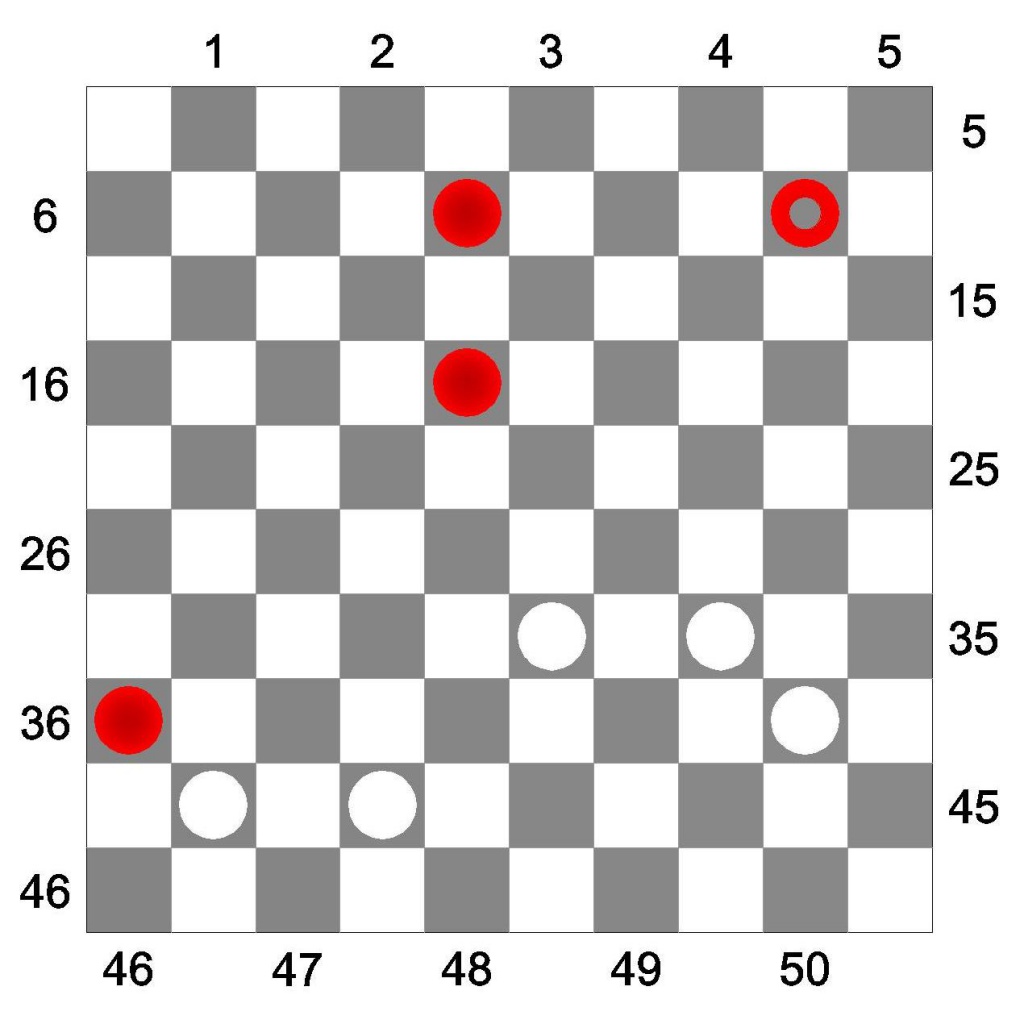
| 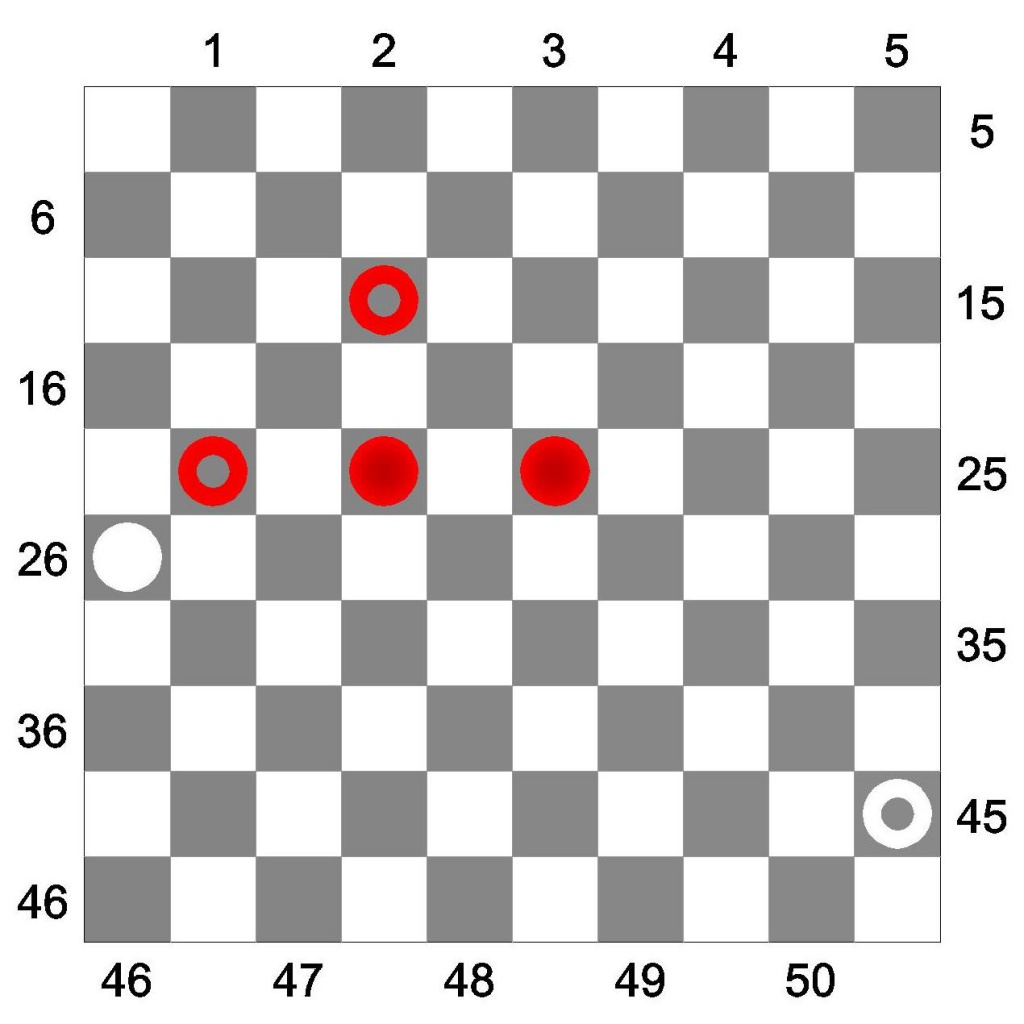
|
|
|
Diagram 6
Queen 10 can take one checker, entering square 46. Simple checker 36, removes 3 opponent's checkers, getting on the field 29. Therefore, the capture must be performed by checker 36. |
Diagram 7
White has 2 options for capturing the opponent's checkers: Queen 45 can take 2 simple checkers and a king, becoming on square 16; With a simple checker 26, you can take a king and 2 simple checkers. In all variants, the quality and quantity are the same, so the player makes a capture based on tactical preferences. |
These rules for the game of international (100-cell) drafts are standard, but they can be changed by mutual agreement of the players.
More detailed rules when holding official competitions can be found in the Code of Rules for the sport "Checkers", approved by order No. 481 of the Ministry of Sports and Tourism of Russia dated May 12, 2010.
Brazilian checkers.
Brazilian checkers is played on an 8x8 board according to the rules of international checkers.
The composition of the game:
1. Game board 64 (8x8) cells. Cells in two contrasting colors, usually white and dark (gray or brown), arranged diagonally. All dark (black) fields have specific numbers - from 1 to 32.
2. Checkers of two different colors, 12 pieces each.
Purpose of the game:
Win a game - when the opponent has no checkers left, the opponent's checkers are blocked, or the opponent admitted defeat ahead of schedule.
If it is impossible for any of the participants in the game to win, the game is considered to be ended in a draw.
Rules:
The game is played by 2 players. Players are positioned on opposite sides of the board.
The playing field (board) is located in such a way that the corner dark field is located on the player's left side.
The choice of color by the players is determined by lot or by agreement. Checkers are placed on three rows closest to the player on dark cells. The first move usually belongs to the player who plays white (light). The moves are carried out by the opponents alternately.
At the beginning of the game, all the opponents' checkers are simple. Simple checkers can only be moved forward diagonally to an adjacent free square.
If a simple checker reaches the last rank, it becomes a king and is indicated by a flip. The queen can move along the diagonals to any number of free cells.
A move is considered made if the participant of the game, after moving the checker, released his hand. If a player touched a checker, he is obliged to make a move to it. If any of the opponents wants to correct the checkers, he is obliged to warn in advance.
Taking a checker the opponent is carried out by transferring his own through it, in the event that it is located on a diagonal cell adjacent to a simple checker and there is a free field behind it. If after this move there is a continuation for capturing, the move continues, and the option is chosen according to the "majority rule", i.e. capturing the largest number of opponent's checkers, in this case the king does not enjoy any advantages and does not impose any additional obligations on the player.
The capture of the opponent's checker can be carried out both forward and backward, and is mandatory, if before the start of the game it has not been agreed to change this rule. The opponent's checker (s) is removed from the board.
If a simple checker, in the process of capturing the opponent's checkers, reaches the field of the last rank and it is given the opportunity to further capture by the king according to the rules of the fight, then it turns into a king, stopping on the field of the last row. She acquires the right to capture according to the rules of the king only from the next move.
English checkers (American checkers)
The composition of the game:
Purpose of the game:
Win a game - when the opponent has no checkers left, the opponent's checkers are blocked, or the opponent admitted defeat ahead of schedule.
If it is impossible for any of the participants in the game to win, the game is considered to be ended in a draw.
Rules:
The game is played by 2 players. Players are positioned on opposite sides of the board.
At the beginning of the game, all the opponents' checkers are simple. Simple checkers can only be moved forward diagonally to an adjacent free square.
If a simple checker reaches the last rank, it becomes a king and is indicated by a flip. The queen can move one square diagonally forward or backward
A move is considered made if the participant of the game, after moving the checker, released his hand. If a player touched a checker, he is obliged to make a move to it. If any of the opponents wants to correct the checkers, he is obliged to warn in advance.
Taking a checker the opponent is carried out by transferring his own through it, in the event that it is located on a diagonal cell adjacent to a simple checker and there is a free field behind it. Capturing an opponent's checker with a simple checker can only be done forward. The queen, when captured, moves only through one square in any direction, and not on any diagonal square, as in Russian or international drafts. Capturing the opponent's checker is obligatory, but if there are several continuations of the "fight", any one that is most tactically expedient is chosen (the main criterion is the absence of further continuations for captures).
If a simple checker, in the process of capturing the opponent's checkers, reaches the field of the last rank and it is given the opportunity to further capture by the king according to the rules of the fight, then it turns into a king, stopping on the field of the last row. She acquires the right to capture according to the rules of the king only from the next move.
Pool
The rules of the game in Pool are very similar to Russian checkers, but, nevertheless, differ.
The composition of the game:
1. Game board 64 (8x8) cells. Cells in two contrasting colors, usually white and dark (gray or brown), arranged diagonally.
2. Checkers of two different colors, 12 pieces each.
Purpose of the game:
Win a game - when the opponent has no checkers left, the opponent's checkers are blocked, or the opponent admitted defeat ahead of schedule.
If it is impossible for any of the participants in the game to win, the game is considered to be ended in a draw.
Rules:
The game is played by 2 players. Players are positioned on opposite sides of the board.
The playing field (board) is located in such a way that the corner dark cell is located on the left side of the player.
The choice of color by the players is determined by lot or by agreement. Checkers are placed on three rows closest to the player on dark cells. The first move usually belongs to the player who plays with white (light) checkers. The moves are carried out by the opponents alternately.
At the beginning of the game, all the opponents' checkers are simple. Simple checkers can only be moved forward diagonally to an adjacent free square.
If a simple checker reaches the last rank, it becomes a king and is indicated by a flip. The queen can move along the diagonals to any number of free cells.
A move is considered made if the participant of the game, after moving the checker, released his hand. If a player touched a checker, he is obliged to make a move to it. If any of the opponents wants to correct the checkers, he is obliged to warn in advance.
Taking a checker the opponent is carried out by transferring his own through it, in the event that it is located on a diagonal cell adjacent to a simple checker and there is a free field behind it. Capturing an opponent's checker with a simple checker can only be done forward. The capture of the opponent's checkers by the king can be carried out through any number of diagonal cells, provided there is free space behind the "victim". If it again finds itself on the same diagonal next to or at a distance from the opponent's checker, behind which there is one or several free squares, the king must continue to capture the next and occupy any free square on the same diagonal behind the last captured checker.
Capturing the opponent's checker is obligatory, but if there are several continuations of the "fight", any one that is most tactically expedient is chosen (the main criterion is the absence of further continuations for captures).
If a simple checker in the process of capturing the opponent's checkers reaches the field of the last rank and it is given the opportunity to further capture, then the checker continues the "fight", while remaining simple.
Italian checkers
The rules of the game of Italian checkers are similar to Checkers, but differ nonetheless.
The choice of color by the players is determined by lot or by agreement. Checkers are placed on three rows closest to the player on dark cells. The first move usually belongs to the player who plays with black (dark) checkers. The moves are carried out by the opponents alternately.
At the beginning of the game, all the opponents' checkers are simple. Simple checkers can only be moved forward diagonally to an adjacent free square.
If a simple checker reaches the last rank, it becomes a king and is indicated by a flip. The Queen has the right to move one square forward or backward diagonally.
A move is considered made if the participant of the game, after moving the checker, released his hand. If a player touched a checker, he is obliged to make a move to it. If any of the opponents wants to correct the checkers, he is obliged to warn in advance.
Taking a checker the opponent is carried out by transferring his own through it, in the event that it is located on a diagonal cell adjacent to a simple checker and there is a free field behind it. Capturing an opponent's checker with a simple checker can only be done forward. It is forbidden for a simple checker to "beat" the king. The queen, when captured, moves only through one square in any direction, and not to any diagonal square, as in Russian or international drafts. Capturing the opponent's checker is mandatory, but if there are several continuation of the “fight”, the option is chosen according to the “majority rule”, i.e. capturing the largest number of opponent's checkers, in this case the king does not enjoy any advantages and does not impose any additional obligations on the player.
If a simple checker, in the process of capturing the opponent's checkers, reaches the field of the last rank and it is given the opportunity to further capture by the king according to the rules of the fight, then it turns into a king, stopping on the field of the last row. She acquires the right to capture according to the rules of the king only from the next move.
At the beginning of the game, all the opponents' checkers are simple. Simple checkers can only be moved forward diagonally to an adjacent free square.
If a simple checker reaches the last rank, it becomes a king and is indicated by a flip. The queen can move along the diagonals to any number of free cells.
Taking a checker the opponent is carried out by transferring his own through it, in the event that it is located on a diagonal cell adjacent to a simple checker and there is a free field behind it. If after this move there is a continuation for capturing other opponent's checkers, the move continues. The opponent's checker (s) is removed from the board. The capture of the opponent's checker can be carried out both forward and backward, and is mandatory, if before the start of the game it has not been agreed to change this rule.
The capture of the opponent's checkers by the king can be carried out through any number of diagonal cells, provided there is free space behind the "victim". If it again finds itself on the same diagonal next to or at a distance from the opponent's checker, behind which there is one or several free squares, the king must continue to capture the next and occupy any free square on the same diagonal behind the last captured checker.
Capturing the opponent's checker is compulsory, but if there are several continuation of the “fight”, the option is chosen according to the “majority rule”, i.e. capturing the greatest number of opponent's checkers
In those cases when a simple checker, when captured, reaches the last horizontal row and it is given the opportunity to further capture checkers, then it is obliged to continue the fight with the same move, but already with the rights of a king.
In those cases when a checker reaches the last rank without capturing and after that it is given the opportunity to fight, then it must beat, provided that this opportunity is preserved only by the next move as a king.
Broken checkers are removed from the board only at the end of the move, repeated "jumping" over broken checkers is prohibited.
